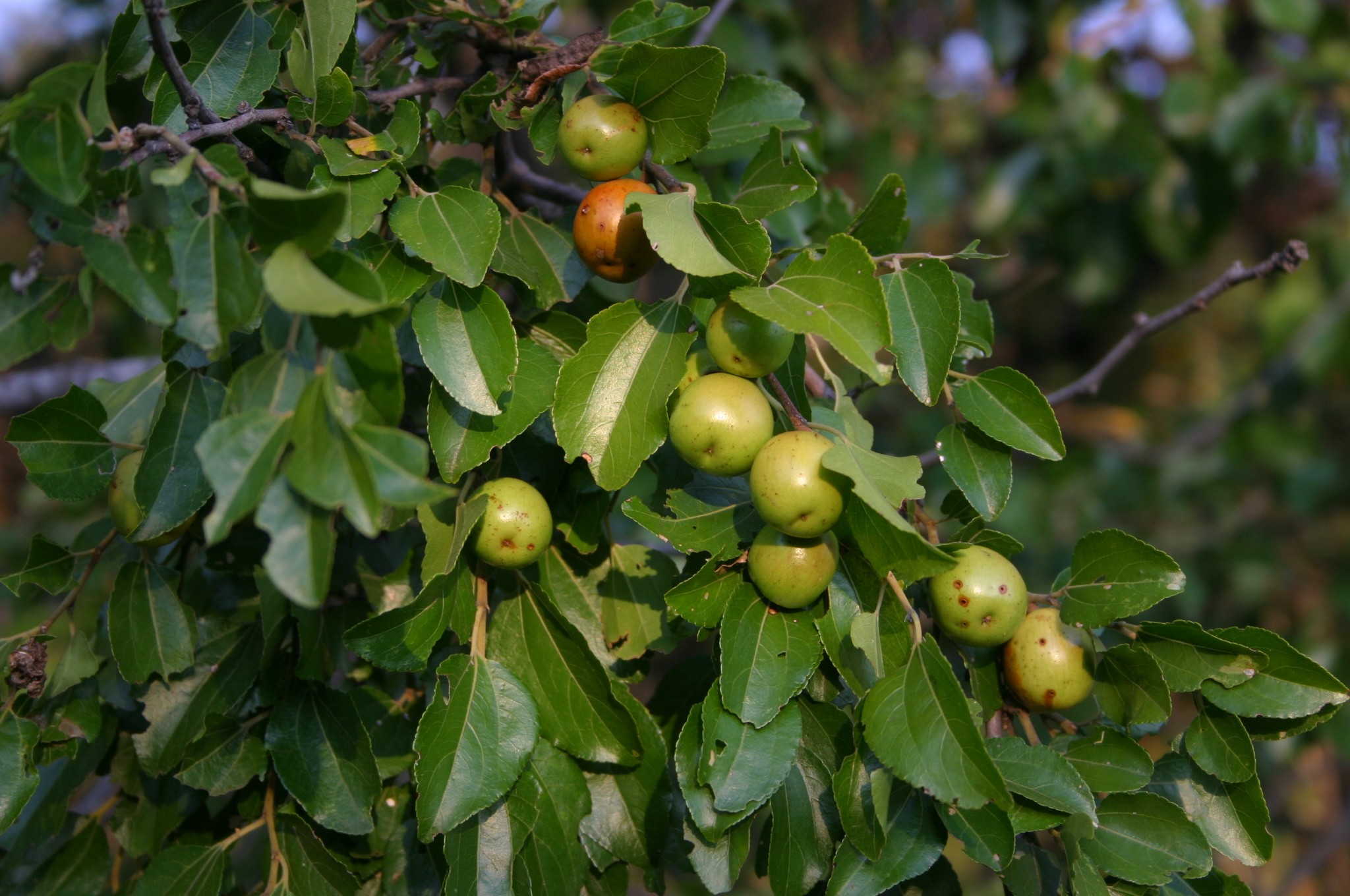Ziziphus mucronata Willd

|
|
Ziziphus mucronata Common Names: Buffalo Thorn, Cape Thorn Scientific
Classification Kingdom: Plantae Phylum: Tracheophyta Class: Magnoliopsida Order: Rosales Family: Rhamnaceae Genus: Ziziphus Species: Ziziphus
mucronata Synonyms: Ziziphus madecassus H.Perrier, Ziziphus mitis A.Rich.,
Ziziphus bubaliana Schult., Ziziphus baclei DC., Ziziphus adelensis Delile,
Ziziphus mucronata subsp. rhodesica R.B.Drumm., Ziziphus mucronata var.
glabrata Sond. (Plants of the World Online, n.d.; Coates Palgrave, 2002). Morphological Description Ziziphus mucronata is a
deciduous to semi-evergreen small to medium-sized tree or shrub, typically
growing to 3–17 meters tall, with a spreading canopy up to 10 meters wide. Its
distinctive zigzag branchlets and thorn pairs one hooked, one straight make it
easily recognizable. Key features include: · Stems: Young stems red-brown, pubescent; mature
bark rough, dark grey to brown, fissured; branchlets zigzag with stipular
spines (Coates Palgrave, 2002). · Leaves: Alternate, ovate to elliptic, 2–8 cm
long, 1–5 cm wide, shiny light green, serrate margins, three-veined from base;
petioles 2–10 mm long (PlantZAfrica, n.d.). · Flowers: Small, greenish-yellow, 3–4 mm
diameter, in axillary cymes; flowering October–April in southern Africa
(Mongalo et al., 2020). · Fruit: Spherical drupes, 10–15 mm diameter, deep
brown-red when ripe, single-seeded, edible; fruiting February–August (Useful
Tropical Plants, n.d.). · Roots: Deep, extensive, enabling drought
tolerance and soil stabilization (Coates Palgrave, 2002). The tree’s thorns deter
herbivores, while its fruits attract birds and mammals, aiding seed dispersal
(PlantZAfrica, n.d.). Distribution and Habitat Ziziphus mucronata is
widely distributed across sub-Saharan Africa, from Senegal and Ethiopia to
South Africa, including Angola, Botswana, Namibia, Zimbabwe, and Nigeria. It
also occurs in Madagascar and the Middle East (e.g., Yemen). It thrives in
diverse habitats: · Open Woodlands: Common in savannas and mixed
woodlands with annual rainfall of 400–1,200 mm (Coates Palgrave, 2002). · Riverine and Alluvial Soils: Prefers
well-drained, sandy, or loamy soils, often on riverbanks or termite mounds,
tolerating clay and rocky substrates (PlantZAfrica, n.d.). · Disturbed Areas: Found in degraded lands,
roadsides, and secondary forests, reflecting its adaptability to heat, drought,
and frost (Useful Tropical Plants, n.d.). Its ecological
versatility and tolerance of extreme conditions (temperatures from -5°C to
40°C) make it a resilient species across varied climates (Mongalo et al.,
2020). Ethnopharmacology Ziziphus mucronata is a
cornerstone of African traditional medicine, used across South Africa, Nigeria,
Senegal, and Zambia for treating over 46 ailments, including infections, pain,
and inflammatory disorders. Ethnopharmacological studies confirm its
bioactivity, driven by cyclopeptide alkaloids (e.g., mucronines F, G, H),
flavonoids, and triterpenoids. Key medicinal uses include: · Antimicrobial: Leaf and bark extracts show
strong activity against Staphylococcus aureus (MIC = 0.39 mg/mL), Escherichia coli (MIC = 0.78 mg/mL), and Candida albicans (MIC = 1.56
mg/mL), validating use for skin infections and venereal diseases (e.g.,
gonorrhea, syphilis) (Mongalo et al., 2020; Olajuyigbe & Afolayan, 2011). · Anti-inflammatory: Root and leaf decoctions
reduce inflammation in rat models (paw edema reduction by 40% at 200 mg/kg),
attributed to flavonoids and saponins, supporting use for boils, sores, and
swelling (Mpiana et al., 2008). · Antimalarial: Dichloromethane bark extracts show
potent antiplasmodial activity against Plasmodium falciparum (IC50 = 5.49
µg/mL), with betulinic acid and lupeol as active compounds, supporting
traditional malaria treatment (Mokgotho et al., 2024). · Antidepressant/Anxiolytic: Hydromethanolic leaf
extracts (150–600 mg/kg) reduce depressive behaviors in rats (sucrose
preference restored by 30%), likely via monoamine modulation and antioxidant
effects, validating use for mood disorders (Keugong et al., 2022). · Antidiabetic: Leaf extracts lower blood glucose
in streptozotocin-induced diabetic rats (25% reduction at 300 mg/kg),
attributed to flavonoids, supporting use for diabetes management (Mokgolodi et
al., 2011). · Analgesic: Root decoctions exhibit analgesic
effects in mice (50% reduction in writhing at 200 mg/kg), linked to alkaloids
and saponins, confirming use as a painkiller for dysentery and wounds (Mpiana
et al., 2008). Phytochemicals include
cyclopeptide alkaloids (mucronines), triterpenoids (betulin, lupeol), flavonoids
(quercetin), phenolics, and saponins, which underpin its broad pharmacological
profile. However, clinical studies are limited, and standardization of doses is
needed (Mongalo et al., 2020; El Maaiden et al., 2020). ⚠ Toxicity Profile: Limited data exist on Ziziphus mucronata toxicity, but studies
suggest low to moderate risk with proper use. Key findings include: Acute
Toxicity: Methanol leaf and root extracts show LD50 of 4,560 µg/mL and 1,180
µg/mL, respectively, in brine shrimp assays, indicating low toxicity; no
cytotoxicity to Vero cells at 100 µg/mL (Mongalo et al., 2020). Cytotoxicity:
Ethyl acetate and dichloromethane bark extracts exhibit moderate cytotoxicity
to CHO cells (CC50 = 10.01–10.96 µg/mL), suggesting caution with high doses (Buthelezi
et al., 2024). Human Risk: No human toxicity cases are reported, but
traditional use warns against excessive consumption of unripe fruits or
prolonged use of root extracts, which may cause gastrointestinal upset or liver
stress (Coates Palgrave, 2002). Precautions: Avoid high doses or use during
pregnancy/lactation. Cooking fruits reduces potential antinutritional factors
(e.g., saponins). Further toxicological studies are essential (Buthelezi et
al., 2020). Additional Uses · Food: Ripe fruits are edible, consumed fresh or
dried, with a nutritional profile of 7% sugars, 2% protein, and vitamin C; used
in porridges or fermented beverages in South Africa (Coates Palgrave, 2002). · Cultural: In Zulu culture, branches are used in
burial rituals to guide spirits; trees are planted on graves as markers. The
tree is believed to protect against lightning (PlantZAfrica, n.d.). · Ecological: Provides shade and fodder for
livestock; roots stabilize soil, preventing erosion in riverine areas (Useful
Tropical Plants, n.d.). · Industrial: Wood is used for fuel, fencing, and
tool handles; bark yields a reddish dye for crafts (Coates Palgrave, 2002). References
External Links More Pictures |
|
| Compounds of Ziziphus mucronata Willd | |
| References |